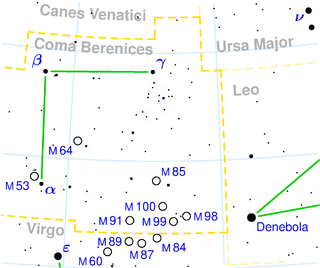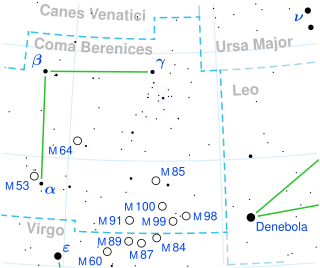
Coma Berenices is an ancient asterism in the northern sky, which has been defined as one of the 88 modern constellations. It is in the direction of the fourth galactic quadrant, between Leo and Boötes, and it is visible in both hemispheres. Its name means "Berenice's Hair" in Latin and refers to Queen Berenice II of Egypt, who sacrificed her long hair as a votive offering. It was introduced to Western astronomy during the third century BC by Conon of Samos and was further corroborated as a constellation by Gerardus Mercator and Tycho Brahe. It is the only modern constellation named for a historic person.

Beta Comae Berenices is a main sequence dwarf star in the northern constellation of Coma Berenices. It is located at a distance of about 29.95 light-years from Earth. The Greek letter beta (β) usually indicates that the star has the second highest visual magnitude in the constellation. However, with an apparent visual magnitude of 4.3, this star is actually slightly brighter than α Comae Berenices. It can be seen with the naked eye, but may be too dim to be viewed from a built-up urban area.

FK Comae Berenices is a variable star that varies in apparent magnitude between 8.14 and 8.33 over a period of 2.4 days. It is the prototype for the FK Comae Berenices class of variable stars. The variability of FK Com stars may be caused by large, cool spots on the rotating surfaces of the stars. This star is thought to be the result of a recent binary merger, resulting in a high rate of both spin and magnetic activity.
Gamma Comae Berenices, Latinized from γ Comae Berenices, is a single, orange-hued star in the northern constellation of Coma Berenices. It is faintly visible to the naked eye, having an apparent visual magnitude of 4.36. Based upon an annual parallax shift of 19.50 mas as seen from Earth, its distance can be estimated as around 167 light years from the Sun. The star is moving away from the Sun with a radial velocity of +3 km/s.

11 Comae Berenices is a binary star system in the northern constellation of Coma Berenices, located in the sky, east and slightly north of Denebola in Leo, but not nearly as far east as ε Virginis in Virgo. It is about a degree from the elliptical galaxy M85 and two degrees north of the spiral galaxy M100. Based upon an annual parallax shift of 10.7104 mas, the star is located 305 light years away from the Sun. It is visible to the naked eye as a faint, orange-hued star with an apparent visual magnitude of 4.72. This body is moving away from the Sun with a heliocentric radial velocity of +44 km/s.
36 Comae Berenices is a single star in the northern constellation of Coma Berenices. It is faintly visible to the naked eye with an apparent visual magnitude of 4.76. The distance to this star, as determined from an annual parallax shift of 9.3 mas, is 349 light years. It is moving closer to the Earth with a heliocentric radial velocity of −1.5 km/s.

12 Comae Berenices is a binary star system in the northern constellation of Coma Berenices. It is the brightest member of the Coma Star Cluster and is visible to the naked eye with an apparent visual magnitude of 4.80. Although listed as a suspected variable star, there is no photometric evidence of it being variable in luminosity. However, the radial velocity was found to be variable, as announced by W. W. Campbell in 1910. The first orbital solution was published by Vinter Hansen in the 1940s. It is a double-lined spectroscopic binary with an orbital period of 396.5 days and an eccentricity of 0.566.
23 Comae Berenices is a binary star system in the northern constellation of Coma Berenices, situated a few degrees away from the North Galactic Pole. It is visible to the naked eye as a faint, white-hued point of light with an apparent visual magnitude of 4.80. The system is located around 310 light years away from the Sun, based on parallax. It is moving closer to the Earth with a heliocentric radial velocity of −16 km/s.
41 Comae Berenices is a single, orange-hued star in the northern constellation of Coma Berenices. It is visible to the naked eye, having an apparent visual magnitude of 4.80. Based upon an annual parallax shift of 8.6 mas, it is located around 379 light years away. It is moving closer to the Earth with a heliocentric radial velocity of −16 km/s.

37 Comae Berenices is a variable star system located around 690 light years away from the Sun in the northern constellation of Coma Berenices. It has the variable star designation LU Comae Berenices. 37 Comae Berenices was a later Flamsteed designation of 13 Canum Venaticorum. This object is visible to the naked eye as a faint, yellow-hued star with a baseline apparent visual magnitude of 4.88. It is drifting closer to the Earth with a heliocentric radial velocity of −14 km/s.
31 Comae Berenices is a yellow giant star in the constellation Coma Berenices. Its apparent magnitude is about 4.9 and slightly variable. It is a rare FK Comae Berenices variable, a variable star that spins rapidly and has large starspots on its surface. It is currently in the Hertzsprung gap and its outer envelope has just begun convection. In 1989 it was given as a spectral standard for the class G0IIIp.
16 Comae Berenices is a single star in the northern constellation of Coma Berenices. 16 Comae Berenices is the Flamsteed designation. It is a member of the Coma Star Cluster and is visible to the naked eye with an apparent visual magnitude of 4.96. Based upon an annual parallax shift of 11.7 mas, it is located about 279 light years away.

28 Monocerotis is a single star in the equatorial constellation of Monoceros. It has an orange-hue and is faintly visible to the naked eye with an apparent visual magnitude of 4.69. The distance to this star is approximately 450 light years based on parallax, and it has an absolute magnitude of −1.00. The star is drifting further away from the Sun with a radial velocity of +26.7 km/s.
13 Comae Berenices is a probable binary star system in the northern constellation of Coma Berenices. It has an apparent visual magnitude of 5.17, which is bright enough to be faintly visible to the naked eye. With an annual parallax shift of 12.33 mas, it is located around 260 light years from the Sun. It is member of the nearby Coma Star Cluster.

24 Comae Berenices is a triple star system in the northern constellation of Coma Berenices. It is visible to the naked eye, with the brightest component being an orange-hued star with an apparent visual magnitude of 5.03. The system is located at a distance of approximately 269 light-years from the Sun based on parallax, and is drifting further away with radial velocities of 3–5 km/s.

21 Comae Berenices is a variable star in the northern constellation of Coma Berenices. It has the variable star designation UU Comae Berenices, while 21 Comae Berenices is the Flamsteed designation.

HD 111395 is a single, variable star in the northern constellation of Coma Berenices. It has the variable star designation LW Com, short for LW Comae Berenices; HD 111395 is the Henry Draper Catalogue designation. The star has a yellow hue and is just bright enough to be barely visible to the naked eye with an apparent visual magnitude that fluctuates around 6.29. Based upon parallax measurements, it is located at a distance of 55.8 light years from the Sun. The star is drifting closer with a radial velocity of −8.9 km/s. It is a member of the Eta Chamaeleontis stellar kinematic group.
LoTr 5 is a large, faint planetary nebula in the constellation of Coma Berenices. In 2018, its parallax was measured by Gaia, giving a distance of about 1,650 light-years.

V1794 Cygni is a single variable star in the northern constellation Cygnus. It has the identifier HD 199178 from the Henry Draper Catalogue; V1794 Cygni is its variable star designation. With an apparent visual magnitude of 7.24, it's too dim to be visible with the naked eye but can be seen with binoculars. V1794 is located at a distance of 367 light-years (113 pc) based on parallax measurements, but is drifting closer to the Sun with a radial velocity of −31 km/s. It lies superimposed over a region of faint nebulosity to the west of the North American Nebula.

17 Comae Berenices is a multiple star system in the northern constellation of Coma Berenices. The brighter component, 17 Com A, is a naked eye star with an apparent visual magnitude of 5.2. It has a faint companion of magnitude 6.6, 17 Com B, positioned at an angular separation of 146.4″ along a position angle of 251°, as of 2018. They are located at a distance of approximately 240 light years from the Sun based on parallax measurements.











